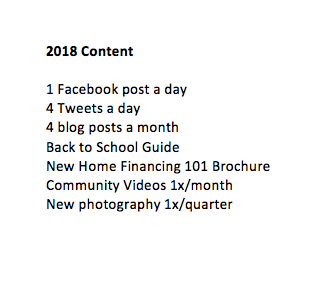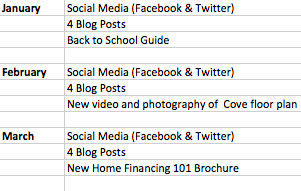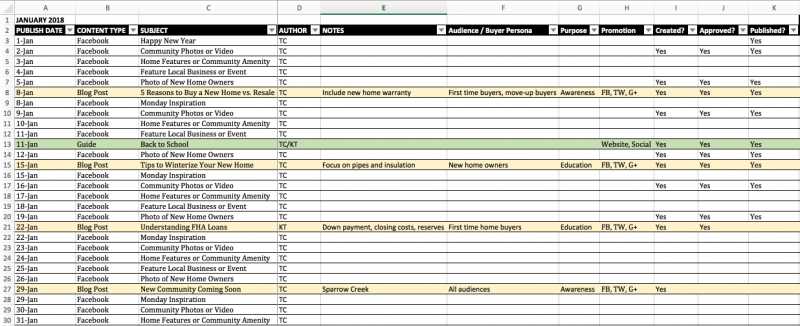Guest Post | Getting Started with Content Planning
February 1, 2018
This week for our #ThoughtfulThursday column, Thaïs Cuffy, Marketing Manager for Lasso Data Systems is sharing a great strategy to developing a content strategy for your business. Whether you’re on one platform or many, these tips are bound to help you be more organized and efficient! As she mentions, content development is a marketing discipline – it takes time and energy, but the rewards and payoff are great when done consistently!
“Content” is a marketing buzzword these days. There are so many formats and platforms to consider – blogs, social media, video, how-to guides, infographics, photos and more. Where do you start? How do you stay organized?
If you’ve had these questions, you’re not alone. Although 75 percent of marketers are increasing investment in content marketing (Curata), a whopping 70 percent of them lack a consistent or integrated content strategy (Altimeter).
Even if your business is committed to just a few platforms – like Facebook and a blog – you must have a plan in order to realize content’s full potential. Otherwise, it’s like batting a baseball blindfolded – you don’t know where to hit or where the ball is going. Content marketing can help you increase brand awareness, credibility and lead volume once you take the blindfold off and develop a strategy. Follow these tips for planning content, and soon you’ll be hitting the ball out of the park!
Start Big, then Drill Down
To start, think about what you want to accomplish in a year. Is it five Facebook posts every week? Four blog posts a month? Would it be helpful to your audience to publish any guides or videos? How about photography of your communities? This is all content. Open a blank document and jot down your ideas, like this:
Next, organize your content ideas by month. If a “Guide to Local Schools” is on your list, you might publish this in January, when parents are considering options for the next school year. Your document might now look something like this:
The next part is where the serious planning begins – using a calendar.
The Content Calendar
The keys to content are consistency and relevance. You want your audience to expect regular content that is meaningful to them. The goal is to establish yourself as a trusted source. To stay on track and add a level of accountability, use a content calendar.
A calendar allows you to plan content daily, weekly, monthly, quarterly and annually across a variety of platforms. As a result, you’ll no longer need to think about what to create; you can just get started. Already knowing the five “Ws” (who, what, where, where and why), you’ll be prepared to execute projects faster, with more clarity and purpose. Creating content can be a full-time job; planning makes it easier.
Content calendars range from just a few fields to dozens, depending on how strategic you want to get. Basic fields for organizing content should include:
- Publish Date
- Content Type
- Author
- Notes
- Audience/Buyer Persona
- Purpose
- Promotion
You could include additional fields to keep track of progress, like:
- Created
- Approved
- Published
Here’s what that calendar might look like:
TIP: You can find examples of content calendars that range from simple to detailed here:
Set Deadlines & Finalize Details
We’ve already determined the content type (ex. blog) and frequency (ex. 4x/month). Now it’s time to set publish dates for each piece of content, including social media posts. As you fill in dates, your calendar starts taking shape.
The next step is to plug in the subject for each content piece, along with the audience, purpose, and any reference notes. Be as detailed as possible. Think about the type of information that would resonate with your particular audience, and plan content around that. Content marketing is all about being helpful and answering potential questions. You can use buyer personas and various analytics tools within your CRM and social media platforms to determine which topics resonate most. Your blog calendar for one month may begin to look like this:
Plan Quarterly
Make it a practice to develop your content calendar one quarter in advance. For example, your calendar for Q1 2018 would have been planned in Q4 2017. This may take a few days of planning, but by the time the start of the quarter rolls around, you won’t have to think of the content you want to publish. Having a calendar allows you to plan in advance for when to start working on each project. Supplement your calendar with reminders and notifications in your own scheduling or productivity tools, like Lasso, Outlook or Basecamp.
TIP: There are content productivity tools that allow you to create calendars, assign tasks and schedule deadlines using one system. Examples of these are Contently and Kapost. These work well for large teams or companies that produce large volumes of content.
Allow for flexibility
Your content calendar serves as a guideline. Remember that impromptu requests will come up. This is expected and fine! Plug in the new content and move around the other items as necessary. You may end up pushing some items into the next month or quarter. It’s a good thing to have too many content options!
Content has become a major marketing discipline, and it should be treated with as much importance as advertising or public relations. You’d never launch an advertising or PR campaign without a plan. You can hit a home run with your content marketing with the right plan in place.
About the Author – Thaïs
Thaïs Cuffy is Marketing Manager for Lasso Data Systems, a leading CRM solution for new home sales and marketing professionals. She has over 10 years of marketing experience in the real estate industry. Currently, Thaïs manages all of Lasso’s marketing programs, including a robust content calendar. She has contributed to a number of online and print publications, including Building Women magazine. Prior to joining Lasso five years ago, she worked for one of the Southeast’s largest sales and marketing agencies, specializing in condo and townhome development. Follow Lasso on Twitter here.
Related Posts:
Categorised in: Content Marketing, Guest Blogs, Thoughtful Thursdays















